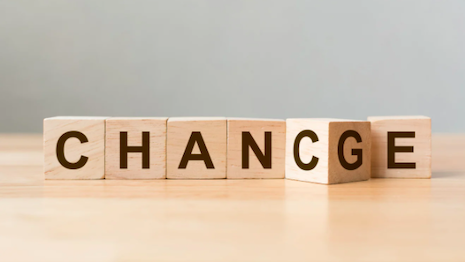 Chance leads to change
Chance leads to change
By Kenn Adach
The COVID-19 coronavirus crisis is dramatically changing consumer and business behavior today. Undoubtedly, many of those behavioral changes will remain long after the diminishment and defeat of the virus.
New behavior becomes permanent the longer it is in place. And in this case, one of the primary human emotions, fear, propels and engrains the behavior changes.
Change is constant
Organizations must consider how the current crisis will also change long-term social interactions, events, and personal contacts as well as what products and services will better serve them in the new post COVID-19 world.
Many people will certainly have higher sensitivity to germs and the risks of spreading infections. This behavior alone will change many industries.
Customers and workers will be more skeptical of close contact with others. Consumers’ travel, dining, entertainment and product preferences will be different tomorrow.
The list of changed behavior and its impact will surely be long, though still to be formed as COVID-19 runs its course.
The number of behavior changes will grow depending on how many people are directly affected, how severely and for how long.
Many new behavioral patterns will be normalized as customers practice them repeatedly over months.
How will behavior shift in your industry?
Many customer behavior changes will require new or modified products and services.
New market leaders will emerge while some past leaders falter. Many companies will struggle post COVID-19.
Proactive approach
Knowing your marketplace, customers and consumer needs are key to meeting market demands and win – but what you knew before may not serve you well in an altered tomorrow.
Smart companies will adopt a proactive approach to understand what changes will occur and be ready to adjust their products, services and strategies quickly to meet current and future customer needs.
Three important steps to take now
Debrief: Convene key members of your team and debrief them on what they have been hearing from customers.
Having a work session to identify what might be changing and, importantly, what you do not know about the “changes” will set the stage for the next step.
Gather insight: Develop a plan to “take the temperature” of the marketplace. How can we validate new behavior we are seeing and hearing, and gather the information we do not know?
Do not assume anything. Your customers can tell you what they will need, but you must ask them.
In this time of rapid change, it is critical to conduct customer interviews, surveys, market research or customer feedback by other means.
Gather the comments, attitudes and data, then analyze. And please be objective, that is, be open to things you may have never thought would occur, and to how it can impact you.
When interacting with customers during this difficult period, train your people to open conversations with, “How can we help you get through this?” not, “Here’s what we’ve got.”
In other words, lead with empathy, not competence. Try to be part of the solution to their crisis.
Re-plan: You have your 2020 plans, but clearly COVID-19 requires forward thinking, new strategies and re-planning on many fronts.
Armed with these new insights from the marketplace, re-plan and prioritize strategies and tactics in all critical areas.This could include manufacturing/operations, sales, marketing communications, new product development/innovation, customer service and other areas.
Understanding what your customers will value in the post-COVID-19 business world and acting on it will ensure your survival and success and put you ahead of major competitors. This cannot be over-emphasized.
Knowing the customer will sort the post-COVID-19 business winners from losers and also-rans.
It is also important to remember that customers buy value, and value comes from meeting their needs, which comes from understanding their needs, in their words and actions.
Focus on providing value, and revenue and profit will take care of itself.
Industry examples
Positive impact: Makers of some key medical products are benefiting from the coronavirus pandemic. For example, this includes products that protect healthcare professionals and consumers from the risks of spreading infection such as thermometers, disposable gowns and gloves and masks, to mention a few.
With significantly increased demand today, these manufacturers should be asking, is this temporary or permanent, how long will it last, and what needs will persist going forward?
Despite this favorable impact, gaining customer insights on need changes is critical to make this short-term success permanent.
Negative impact: Here, the list of industries is very long, and many will be transformed in a post-COVID-19 business world. Dining and hospitality, travel and entertainment, and related suppliers are just a few that have been essentially shuttered.
The question going forward is, when will their customers come back?
But even more important and more under their control is, what will they need to deliver differently in terms of product or service features and benefits?
Historical post-COVID-19 business impact
History provides validation that major changes will occur.
Look back at 9/11 or even the financial crisis of 2009.
The post-9/11 world brought us tighter airport security, the creation of the U.S. Transportation Security Administration and the U.S. Department of Homeland Security, and increased security at everything from sporting events and concerts to large office buildings in major cities. Behavior changed, industries were changed and created, and they will be again.
Many believe that COVID-19 will affect more consumers and businesses directly and will have a more far-reaching impact on businesses of all types than any crisis in the past half-century.
ON THE BRIGHTER SIDE, remember that change creates opportunity.
Business leaders who act now, communicate with customers and take a proactive approach to their changing markets will do much better than those who do not.
 Kenn Adach is partner and chief marketing officer at Chief Outsiders
Kenn Adach is partner and chief marketing officer at Chief Outsiders
Kenn Adach is partner and chief marketing officer at Chief Outsiders. Reach him at kadach@chiefoutsiders.com.
